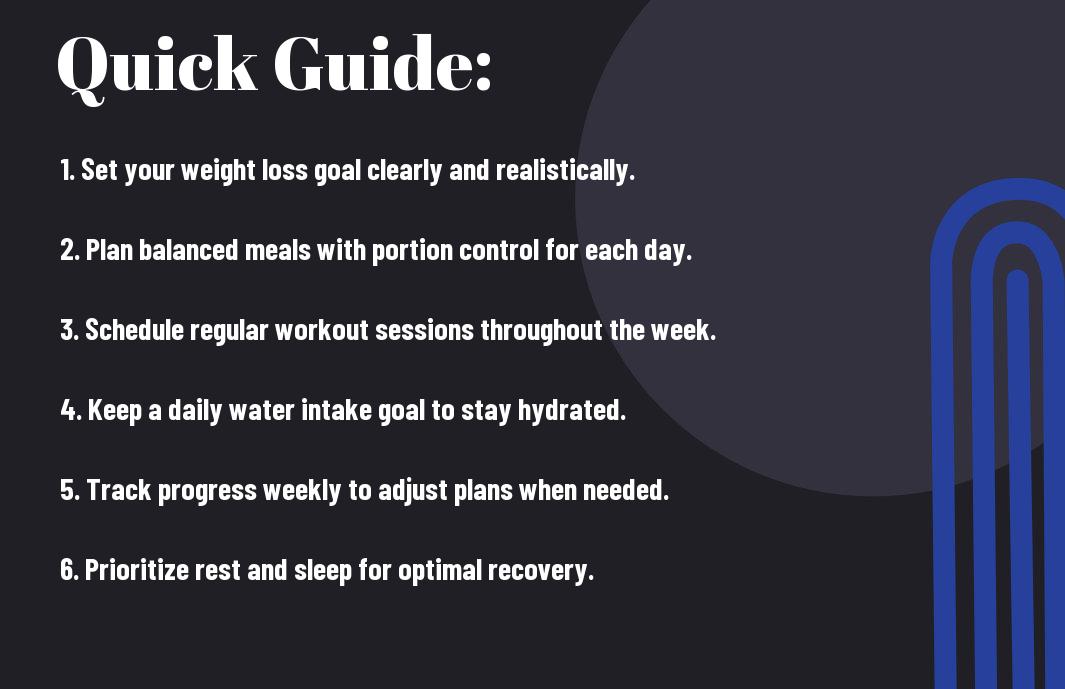Weight loss success hinges on a well-structured daily routine designed to fit your lifestyle. By following a tailored daily schedule, you can establish healthy habits, keep track of your meals, workouts, and self-care activities. This guide will walk you through creating an effective weight loss daily schedule template to help you stay organized, accountable, and motivated on your journey. You will gain insights into meal planning, exercise timing, and ways to incorporate wellness practices that can elevate your results and nurture your overall health.

Key Takeaways:
- Structure: A daily schedule provides a clear framework for organizing meals, workouts, and rest periods.
- Consistency: Following a routine helps develop healthy habits that promote sustainable weight loss.
- Meal Planning: Incorporate a variety of nutritious foods and snacks, balancing macronutrients for optimal energy.
- Exercise Inclusion: Schedule time for physical activities, varying intensity levels to boost metabolism.
- Hydration: Regularly drink water throughout the day to maintain hydration, supporting overall health and weight loss efforts.
- Rest and Recovery: Prioritize sleep and recovery techniques to aid in weight loss and improve overall well-being.
- Flexibility: Allow room for adjustments in the schedule to accommodate unexpected events while staying on track with goals.
Types of Weight Loss Schedules
While there are various approaches to weight loss, selecting the right schedule can greatly affect your results. Below are a few popular types:
- Intermittent Fasting
- Calorie Counting
- Portion Control
- Meal Prep
- Flexible Dieting
This variety allows you to choose a method that aligns with your lifestyle and preferences.
| Type | Description |
| Intermittent Fasting | Cycling between eating and fasting periods. |
| Calorie Counting | Tracking the number of calories consumed. |
| Portion Control | Regulating the size of your servings. |
| Meal Prep | Preparing meals in advance to promote healthy choices. |
| Flexible Dieting | Aiming for a balanced intake of macronutrients. |
Intermittent Fasting
Even though the concept is simple, intermittent fasting involves specific eating windows throughout the day. You alternate between periods of eating and fasting, which can help regulate insulin levels and promote fat loss. By choosing this method, you can potentially enhance your metabolic flexibility, allowing your body to switch between burning carbohydrates and fat for energy.
Calorie Counting
Little steps in calorie counting can lead to substantial weight loss results. By tracking your daily caloric intake, you gain a clearer understanding of what and how much you’re consuming, helping you make informed choices. This method encourages mindfulness regarding food and its impact on your body.
Another important aspect of calorie counting is establishing a caloric deficit. This means consuming fewer calories than your body burns, which is imperative for weight loss. You can use various apps or food diaries to simplify tracking, ensuring your intake aligns with your goals while still enjoying the foods you love.
Portion Control
Any effort put into portion control can prevent overeating and help you manage your weight effectively. By regulating serving sizes, you can still enjoy your favorite meals while avoiding excess calories. This method can enhance your relationship with food and promote healthier dietary habits.
Calorie density plays a significant role in portion control. Understanding the difference between high-calorie and low-calorie foods can help you select healthier options that allow for larger portions without exceeding your caloric needs. For instance, vegetables can occupy a substantial part of your plate, keeping you satisfied while staying within your desired caloric range.


Tips for Effective Weight Loss
Even small changes can lead to significant weight loss results. To maximize your weight loss efforts, consider the following tips:
- Track your daily calories and activity levels.
- Incorporate a mix of cardio and strength training into your routine.
- Incorporate more fruits and vegetables into your diet.
- Limit processed foods and sugary beverages.
Any adjustments you make can contribute to your overall success.
Setting Realistic Goals
Goals are vital in providing direction for your weight loss journey. Start by defining specific, achievable targets, such as losing one to two pounds per week. Break down larger goals into smaller milestones to track your progress and stay motivated. This approach ensures you remain focused while celebrating each accomplishment along the way.
Meal Planning Strategies
Even with a busy schedule, effective meal planning can streamline your efforts and help keep your diet on track. Take time each week to plan your meals, focusing on balanced options that include proteins, healthy fats, and whole grains.
Realistic meal planning also involves preparing snacks in advance to avoid unhealthy choices when hunger strikes. You can batch-cook meals or utilize simple recipes that can be easily reheated. Having nutritious options ready will keep you in control of your diet and help you resist the temptation of fast food or other less healthy alternatives.
Staying Hydrated
Setting hydration goals is key to supporting your weight loss efforts. Aim to drink at least eight glasses of water each day, as staying hydrated can help reduce hunger and improve your metabolism.
For instance, drinking water before meals can help you feel fuller, potentially leading to decreased food intake. Carry a reusable water bottle with you and set reminders to drink throughout the day, ensuring that hydration becomes a regular part of your weight loss strategy.
Step-by-Step Weight Loss Schedule Template
To effectively reach your weight loss goals, you can create a structured daily schedule that guides your meals, exercise, and progress tracking. Utilizing Weight Loss templates can help you build a personalized approach, making the journey easier and more organized. Below, you will find a simple template to follow:
| Activity | Time |
|---|---|
| Wake Up | 6:30 AM |
| Breakfast | 7:00 AM |
| Exercise | 8:00 AM |
| Lunch | 12:00 PM |
| Snack | 3:00 PM |
| Dinner | 6:30 PM |
| Journaling | 8:00 PM |
Daily Meal Outline
Even with a busy lifestyle, planning your meals can significantly impact your weight loss journey. Establishing a daily meal outline ensures that you consume balanced, nutritious foods to fuel your body adequately throughout the day. Aim to include a variety of proteins, healthy fats, and whole grains in each meal to maintain energy levels and curb cravings.
Exercise Time Allocation
StepbyStep organizing your exercise routine is fundamental to achieving your weight loss objectives. Allocate specific time blocks in your day for physical activities, aiming for at least 150 minutes of moderate-intensity exercise weekly. This might include walking, jogging, strength training, or fitness classes, depending on your preferences and fitness level.
The consistency of your exercise schedule will likely determine your success. Make sure to choose activities you enjoy, as this increases adherence. Consider breaking your workout into shorter sessions throughout the day to accommodate your schedule. This way, it feels less overwhelming and is easier to incorporate into your daily routine.
Tracking Progress
Progress monitoring enhances motivation and helps you stay accountable. You can maintain a journal or use mobile apps to document your weight, measurements, and workout routines. Tracking how you feel physically and mentally is equally important, as this can provide insight into your overall health improvement.
Understanding the significance of tracking enables you to adjust your schedule according to what works best for you, making your weight loss journey more effective. Celebrate your milestones, big or small, as this reinforces positive habits and encourages you to continue pushing towards your fitness goals.
Factors Influencing Weight Loss
Your weight loss journey is influenced by various factors that can either facilitate or hinder your progress. Understanding these factors is crucial for developing a successful weight loss strategy. Key elements include:
- Metabolism
- Lifestyle Choices
- Psychological Factors
The impact of these factors varies from person to person, emphasizing the importance of tailoring your approach to achieve sustainable results.
Metabolism
The rate at which your body burns calories plays a significant role in weight loss. A faster metabolism means you can consume more calories without gaining weight, while a slower metabolism has the opposite effect. Factors influencing your metabolism include age, gender, muscle mass, and genetics.
Lifestyle Choices
Loss of weight can be greatly affected by your daily habits and choices. This includes your diet, activity levels, sleep quality, and stress management. Making healthier choices in these areas can lead to more effective weight loss.
This can involve prioritizing whole, nutrient-dense foods, engaging in regular physical activity, ensuring adequate sleep, and applying stress-relief techniques, all of which contribute to a balanced lifestyle.
Psychological Factors
One of the less obvious but highly influential aspects of weight loss is your mental state. Factors such as motivation, self-esteem, and emotional well-being can significantly affect your progress. Consider these psychological aspects:
- Motivation levels
- Self-image
- Emotional eating tendencies
This highlights the necessity of a positive mindset and the ability to manage emotional triggers to achieve lasting success in your weight loss journey.
- Setting realistic goals
- Practicing self-compassion
- Seeking support when needed
Understanding these psychological factors can help you develop a healthier relationship with food and a more constructive approach to weight loss.

Pros and Cons of Various Weight Loss Methods
Many people struggle with finding the right weight loss method for their individual needs. Each method has its own benefits and drawbacks that can influence your decision. Below is a breakdown of the pros and cons of various weight loss techniques:
| Pros | Cons |
|---|---|
| Easy to follow plans | May lead to boredom |
| Flexibility in food choices | Can be overwhelming with options |
| Structured schedules promote consistency | May require meal prep time |
| Support from community | Potential for comparison with others |
| Increases accountability | Can be difficult to stick to long-term |
| Provides measurable results | Not all methods suit everyone |
| Enhances motivation | May overlook individual needs |
| Access to professional guidance | Potential cost of programs |
| Mix of diet and exercise options | Requires lifestyle changes |
| The Fat Loss Template can help | May lead to frustration with slow progress |
Benefits of Structured Schedules
Now, implementing a structured schedule can significantly enhance your weight loss journey. It helps you establish set meal and exercise times, creating a routine that makes it easier to stay on track. Moreover, having a schedule keeps you accountable, ensuring that you make healthy choices and stick to your goals consistently.
Potential Drawbacks
The potential drawbacks of using a structured schedule can include a sense of rigidity. If you find yourself too constrained by a schedule, it might generate stress rather than motivation. This could lead to feelings of frustration or being overwhelmed, which can affect your overall compliance.
A rigid weight loss schedule might limit your spontaneity and enjoyment of food. If you’re following a strict plan, you may miss out on social events or occasions where you cannot stick to your outlined meals. Additionally, if your schedule doesn’t allow for flexibility, you may struggle to adapt when life throws you curveballs, ultimately hindering your progress.
Troubleshooting Common Weight Loss Challenges
After committing to your weight loss journey, you may encounter various challenges that can hinder your progress. Identifying and addressing these common issues is necessary to stay on track and achieve your goals. By understanding plateaus, managing motivation loss, and overcoming cravings, you can navigate these difficulties effectively and maintain a healthy lifestyle.
Plateaus
Plateaus can be frustrating as you may see little to no progress despite your efforts. This situation often occurs when your body adjusts to your current routine, leading to a stall in weight loss. To overcome plateaus, consider switching up your exercise routine or adjusting your calorie intake to reignite your progress.
Motivation Loss
Weight loss can be an emotional rollercoaster, and it’s common to experience dips in motivation. Life events, stress, and unrealistic expectations can contribute to a lack of enthusiasm. To combat this, establish small, achievable goals and celebrate your progress, no matter how minor. Cultivating a supportive environment and surrounding yourself with positive influences will also help maintain your motivation levels.
Common factors that can lead to motivation loss include boredom with your routine and negative self-talk. Addressing these issues requires a proactive approach. Engage in new physical activities, track your achievements, and practice self-compassion. Joining a community or enlisting a workout partner can provide the encouragement needed to stay motivated and focused on your weight loss journey.
Overcoming Cravings
If cravings derail your weight loss efforts, it’s necessary to understand their root causes. They often stem from emotional triggers, boredom, or simply habit. To successfully manage cravings, try implementing mindful eating strategies and exploring healthier alternatives to your favorite snacks.
With mindful eating, you can identify when you are truly hungry versus when cravings arise from other factors. Focus on nutrient-dense whole foods to satisfy your hunger while staving off cravings. You can also drink water or herbal tea when cravings hit, as hydration often plays a role in the feeling of hunger. Establishing balanced meals can help reduce the frequency and intensity of cravings, ensuring you stay on course towards your weight loss goals.
Final Words
So, as you launch on your weight loss journey, utilizing a daily schedule template can significantly enhance your progress. By organizing your meals, workouts, and self-care activities, you empower yourself to maintain consistency and stay motivated. Implementing this guide allows you to track your achievements and identify areas for improvement, ultimately leading you toward your weight loss goals. Embrace this structured approach, and tailor it to fit your lifestyle, ensuring that you are not only losing weight but also fostering a healthier and more balanced routine.
FAQ
Q: What is a Weight Loss Daily Schedule Template?
A: A Weight Loss Daily Schedule Template is a structured plan that outlines your daily activities focusing on necessary components of weight loss, including meal times, exercise sessions, water intake, and rest periods. It helps individuals stay organized, accountable, and motivated in achieving their weight loss goals.
Q: How can I create a Weight Loss Daily Schedule Template?
A: To create a Weight Loss Daily Schedule Template, start by determining your daily calorie needs and nutritional goals. Next, allocate time slots for meals, exercise, and snacks based on your daily routine. Be sure to include time for hydration and relaxation. You can use various tools such as planners, apps, or printable templates to design your schedule.
Q: What should be included in my daily meal plan?
A: Your daily meal plan should include a balanced mix of proteins, healthy fats, and carbohydrates. Aim for at least three main meals and two snacks throughout the day. Incorporate plenty of fruits and vegetables, and consider portion sizes to stay within your planned calorie intake. It’s also important to account for any dietary restrictions or preferences you may have.
Q: How much exercise should I include in my schedule?
A: The amount of exercise can vary based on individual fitness levels and weight loss goals. Typically, aim for at least 150 minutes of moderate aerobic activity or 75 minutes of vigorous activity each week, combined with strength training on two or more days. Break this down into manageable daily sessions that fit your lifestyle and schedule.
Q: How can I stay motivated to stick to my schedule?
A: Staying motivated involves setting achievable goals, tracking your progress, and celebrating small victories. Consider joining a community or finding a workout buddy for support. Regularly reassess your schedule to keep it fresh and aligned with your goals, and don’t hesitate to adjust when necessary to avoid burnout.
Q: Can I make adjustments to my schedule over time?
A: Yes! Flexibility is key to maintaining a sustainable weight loss routine. As you progress, you may need to increase the intensity of your workouts, change meal options, or adjust portion sizes. Regularly review your progress and make modifications to your schedule as needed to ensure it continues to serve your weight loss journey.
Q: Are there any resources or tools to help with a Weight Loss Daily Schedule?
A: There are many resources available, including mobile apps that track meals and workouts, online weight loss communities for support, and websites offering templates and guides. Additionally, consider consulting with a nutritionist or personal trainer for personalized advice and strategies that suit your specific needs and goals.



